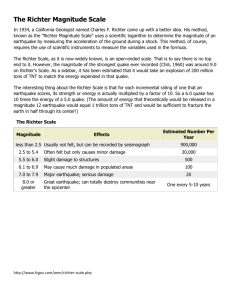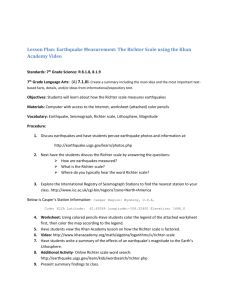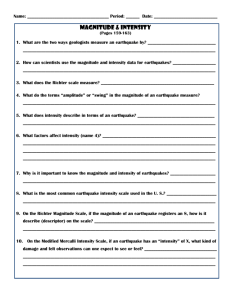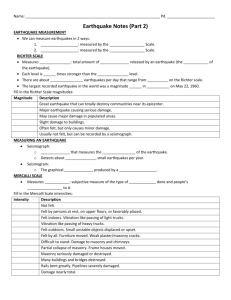Paper 1
advertisement
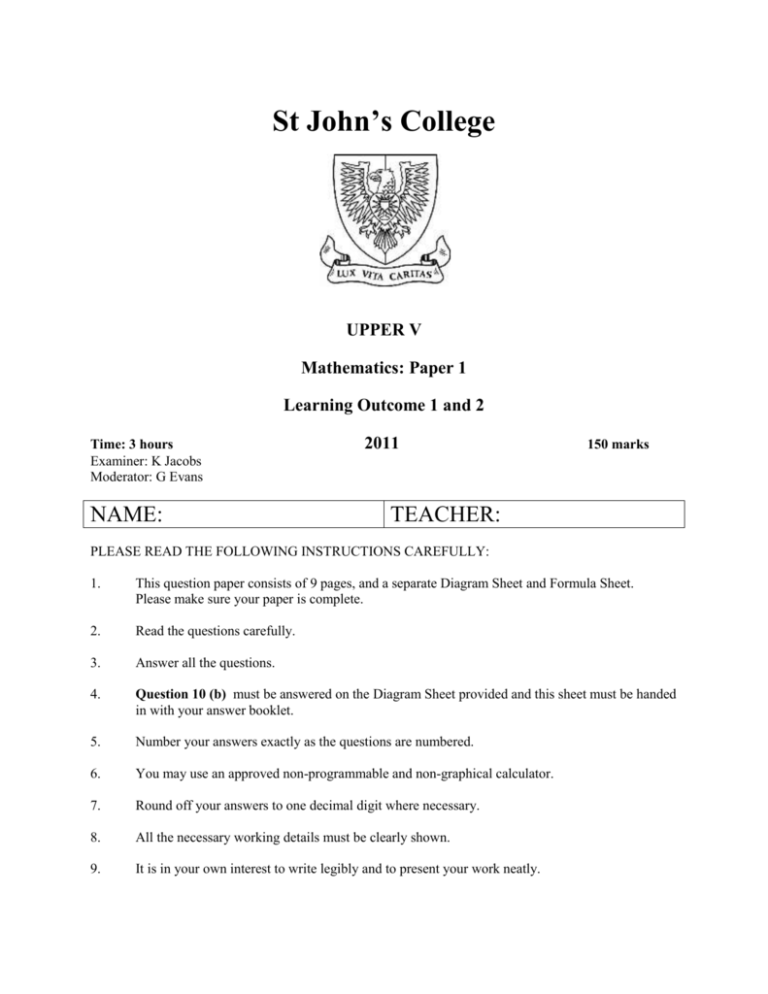
St John’s College UPPER V Mathematics: Paper 1 Learning Outcome 1 and 2 Time: 3 hours Examiner: K Jacobs Moderator: G Evans NAME: 2011 150 marks TEACHER: PLEASE READ THE FOLLOWING INSTRUCTIONS CAREFULLY: 1. This question paper consists of 9 pages, and a separate Diagram Sheet and Formula Sheet. Please make sure your paper is complete. 2. Read the questions carefully. 3. Answer all the questions. 4. Question 10 (b) must be answered on the Diagram Sheet provided and this sheet must be handed in with your answer booklet. 5. Number your answers exactly as the questions are numbered. 6. You may use an approved non-programmable and non-graphical calculator. 7. Round off your answers to one decimal digit where necessary. 8. All the necessary working details must be clearly shown. 9. It is in your own interest to write legibly and to present your work neatly. Page 2 of 9 QUESTION 1 (a) (b) Solve for x: (1) x2 6 x (2) (2) 2 x 20 (2) (3) 3x 12 x 2 (4) Determine the value of: 1 + 4 + 7 + 10 + … + 100 (c) (4) For which value(s) of p will the following equation have no solutions? 3x 5 p 0 (2) [14] QUESTION 2 (a) Given f ( x) x 2 , determine (b) Writing your answers with positive exponents, find dy if: dx 4 x2 x2 4 (1) y (2) y(1 2 x) 4 x 2 1 f '( x) from first principles. (5) (3) (4) [12] Page 3 of 9 QUESTION 3 (a) Determine the equations of the following graphs: (1) f ( x) a.2 x (4) (2) h( x ) 2 x p y y 4 B(-2; 1) 0 x 0 x (b) Write down the asymptote of h(x). (1) (c) Determine h -1(x). (3) (d) Prove that f(x) and h(x) are in fact the same graphs. (2) [10] QUESTION 4 y The feasible region for a linear programming problem is shown in the diagram. One of the lines is given by the equation y 2 x 6 . (a) (b) Write down the three constraints that define the region. 6 4 (3) A (2; 2) An objective function for this problem is 1 P sx ty 0 where s, t and P are positive integers. Write down a possible value for s and t respectively so that P is minimised at A(2; 2). 3 4 (2) [5] x Page 4 of 9 QUESTION 5 Capitec Bank offers the following annual interest rates on a Daily Savings Account as well as the costs involved in having this account. The interest rates are compounded daily. (Assume 365 days in a year). (a) (b) For a R10 000 investment, show that the quoted nominal interest rate is equivalent to 4,76% p.a. compounded monthly. (3) If you invest R10 000 with Capitec Bank, how much money will you have in your account after 1 year, taking into consideration the monthly administration fee which is deducted at the end of each month. (6) [9] QUESTION 6 In each case below, describe in words the transformation on p(x) which results in q(x). p(x) q(x) (a) 3 4 x 1 3 4 x 1 (b) 4x5 0,25x5 (c) x2 2 x 6 ( x 1)2 7 (d) log 2 x 1 2 x [8] Page 5 of 9 QUESTION 7 1 2 3 4 Use the above diagrams to assist you with completing the following table. Write your answers (a) to (g), showing all necessary workings, in your answer book. 1 2 3 4 Line segments in outer pentagon 0 5 10 (a) Dots 1 5 (c) 22 Total line segments 0 5 13 5 (d) 10 (e) (g) Tn (b) (3) (f) (5) (3) [11] QUESTION 8 Two friends, Bongani and Rajesh, are both 19 years old. Bongani starts a savings programme, investing R1 000 at the beginning of each year for each of 7 years at 10% compound interest per annum. At this point (seven years later), Rajesh decides to start saving in the same way, by investing R1 000 at the beginning of each year at the same interest rate in the hope that, one day, his savings will catch up with Bongani’s. Bongani does not put any more money into his account, but he lets what he has saved to this point grow at 10% per annum. (a) Calculate how much money Bongani has in his bank account after 7 years. (4) (b) How old will Rajesh be when his bank balance catches up with Bongani’s. (6) [10] Page 6 of 9 QUESTION 9 f ( x) x 3 - 3x 2 2 (a) (b) Show that x = 1 is a root of f(x). (1) Here is an interesting result which you have probably not seen before: If r is any root of ax3 bx 2 cx d 0 , then we can find the other 2 roots by using the following formula: x b ra b2 4ac 2abr 3a 2 r 2 2a Using this formula, find the other 2 roots of f(x). (3) (c) Determine the turning points of f(x). (4) (d) Hence sketch f(x), showing all necessary points clearly. (3) (e) Determine the value(s) of m such that f (x - m) has only negative roots. (2) [13] QUESTION 10 Food and clothing are shipped to survivors of a natural disaster. Each container of food will feed 12 people, while each container of clothing will help 8 people. Each 0,5 m3 container of food weighs 22,5 kg, and each 0,25 m3 container of clothing weighs 9 kg. The commercial carriers transporting food and clothing are bound by the following constraints: The total weight cannot exceed 8 505 kg. The total volume must not be more than 225 m3. Let x be the number of containers of food, and y be the number of containers of clothing. (a) Write down the set of constraints from the information above. (5) (b) On the graph paper provided, sketch these constraints, showing clearly which area defines the feasible region. (4) (c) State the objective function that represents the number of people who can be helped. (2) (d) How many containers of food and clothing should be sent with each plane shipment to maximise the number of people who can be helped? Show all working. (3) [14] Page 7 of 9 QUESTION 11 (a) Two functions f ( x) 1 2 1 and g ( x) 4 x 8 x x 1 are shown in the sketch below: y g(x) T f(x) 0 x h(x) T is the point of intersection of f (x) and g(x). h(x) is a tangent to both f(x) and g(x) at point T. Determine the equation of h(x). (b) (8) The sum of two positive numbers is 24. If one number is multiplied by the square of the other number, find the maximum value of this product. (c) Determine the maximum value of 1 2 x 12 x 26 2 correct to 2 decimal places. (6) (3) [17] Page 8 of 9 QUESTION 12 (a) (b) The sum of the first n terms of a sequence is given by: Sn n 2 2n . Determine : (1) the sum of the first 8 terms. (1) (2) the 9th term. (3) 2 x 2 x1 3.2x 2x2 ... (15 terms) 15 . 2 x3 Prove: (4) [8] QUESTION 13 f(x) and g(x) are both parabolas, such that: f ( x) g ( x) ; f (1) f (4) 0 ; f '(a) 0 ; f (a) 8 Determine the co-ordinates of the turning point of g(x). [4] QUESTION 14 log 3 x log 2 x (a) Determine for which value(s) of x, (b) How earthquake magnitudes are measured (2) The Richter scale is used by seismologists to measure the magnitude of earthquakes. There is a 10-fold increase from one unit to the next. For example, an earthquake measuring 7 on the Richter Scale has an intensity 10 times greater than an earthquake measuring 6 on the Richter Scale. (1) (2) How many times greater in intensity would an earthquake measuring 9 on the Richter Scale be compared to one measuring 6 on the Richter Scale? (1) On 10 January 2010, the Haiti earthquake was recorded with a Richter Scale of 7. On 26 December 2004, an earthquake in the Indian Ocean was 200 times more intense than the “Haiti” earthquake. Determine the reading on the Richter Scale of the Indian Ocean earthquake. (answer correct to 1 decimal place) (4) Page 9 of 9 (c) A relationship has been discovered between the magnitude of earthquakes and their frequency of occurrence. Complete the following table where N denotes the number of earthquakes per year with magnitude (on the Richter Scale) greater than or equal to M. M 1 N 3341139 log N (to 4 decimal places) (1) 2 (2) 5,6244 3 56144 4,7493 4 7138 3,8536 5 939 2,9727 6 139 2,1430 (2) (3) The graph of log N against M has been plotted below. 7 log N 6 5 1,8 2 4 3 2 1 1 1 1 2 3 4 5 6 7 9 M The line of best fit has been drawn in, which cuts the y-axis at (0; 7,4). Determine the equation of the line of best fit to correct 1 decimal place. (4) 8 (2) Using this equation, determine how many earthquakes per year are recorded for an earthquake with a magnitude of between 7 and 8. (4) [15] END OF EXAMINATION
